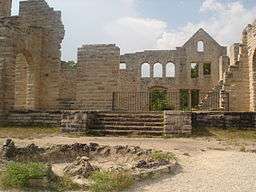Ha Ha Tonka State Park
| Ha Ha Tonka State Park | |
| Missouri State Park | |
 The "castle" ruins at Ha Ha Tonka | |
| Country | United States |
|---|---|
| State | Missouri |
| County | Camden |
| Elevation | 705 ft (215 m) [1] |
| Coordinates | 37°58′08″N 92°46′09″W / 37.96889°N 92.76917°WCoordinates: 37°58′08″N 92°46′09″W / 37.96889°N 92.76917°W [1] |
| Area | 3,709.74 acres (1,501 ha) [2] |
| Established | 1978 [3] |
| Management | Missouri Department of Natural Resources |
| - Park Office | 1491 State Road D Camdenton, Mo. |
| - coordinates | 37°58′59″N 92°46′08.5″W / 37.98306°N 92.769028°W [4] |
| Visitation | 520,828 (2014) [5] |
|
Location in Missouri | |
| Website: Ha Ha Tonka State Park | |
Ha Ha Tonka State Park is a state-owned, public recreation area encompassing over 3,700 acres (1,500 ha) on the Niangua arm of the Lake of the Ozarks, about five miles south of Camdenton, Missouri, in the United States. The state park's most notable feature is the ruins of Ha Ha Tonka, an early 20th-century stone mansion that was modeled after European castles of the 16th century.
The park also features caves, sinkholes, and bluffs overlooking the lake. It is a prominent example of karst topography, which is geological formation shaped by the dissolution of a layer or layers of soluble bedrock.[6] A 70-acre (28 ha) portion of the park was designated as the Ha Ha Tonka Karst Natural Area in 1981.[7]
History
Construction of the Ha Ha Tonka castle was started by Robert McClure Snyder, Sr. in 1905, a Kansas City businessman who purchased the large property. Alluding to the natural springs on the property, "ha ha tonka" was said to mean "smiling waters."[8]
Following Snyder's death in an auto accident in 1906, the castle was completed by his sons Robert, Jr.; LeRoy, and Kenneth Snyder in the late 1920s before the Stock Market Crash. The building was used as a summer and weekend home by the Snyder family, who lived in Kansas City. In the late 1930s it was used as a hotel, but was destroyed by fire in 1942.[9]
The state purchased the castle and grounds in 1978, adapting them for use as a state park and opening them to the public. The water tower was repaired in 2004, with a new roof installed. The castle walls have been stabilized.[10] The ruins can be seen from an observation point across from the post office.
Activities and amenities
The park has 15 miles of hiking trails leading to caves, sinkholes, natural bridges, and the castle. The park also features boating, fishing, and swimming.[6]
References
| Wikimedia Commons has media related to Ha Ha Tonka State Park. |
- 1 2 "Ha Ha Tonka State Park". Geographic Names Information System. United States Geological Survey.
- ↑ "Missouri State Park Advisory Board Annual Report 2008". Missouri Department of Natural Resources. Retrieved August 18, 2015.
- ↑ "State Park Land Acquisition Summary". Missouri State Parks. Missouri Department of Natural Resources. Retrieved August 18, 2015.
- ↑ "Ha Ha Tonka State Park Visitors Center". Missouri State Parks. Missouri Department of Natural Resources. Retrieved October 7, 2015.
- ↑ "Missouri State Park Attendance (2014)" (PDF). Missouri State Parks. Missouri Department of Natural Resources. 2015. Retrieved August 18, 2015.
- 1 2 "Ha Ha Tonka State Park". Missouri State Parks. Missouri Department of Natural Resources. Retrieved September 29, 2014.
- ↑ "Ha Ha Tonka Karst Natural Area". Conservation Commission of Missouri. Retrieved October 7, 2015.
- ↑ "Camden County Place Names, 1928–1945 (archived)". The State Historical Society of Missouri. Retrieved 8 September 2016.
- ↑ "General Info: Ha Ha Tonka State Park". Missouri State Parks. Missouri Department of Natural Resources. Retrieved August 18, 2015.
- ↑ "Ha Ha Tonka's Castle". Missouri State Parks. Missouri Department of Natural Resources. Retrieved August 18, 2015.
External links
- Ha Ha Tonka State Park Missouri Department of Natural Resources